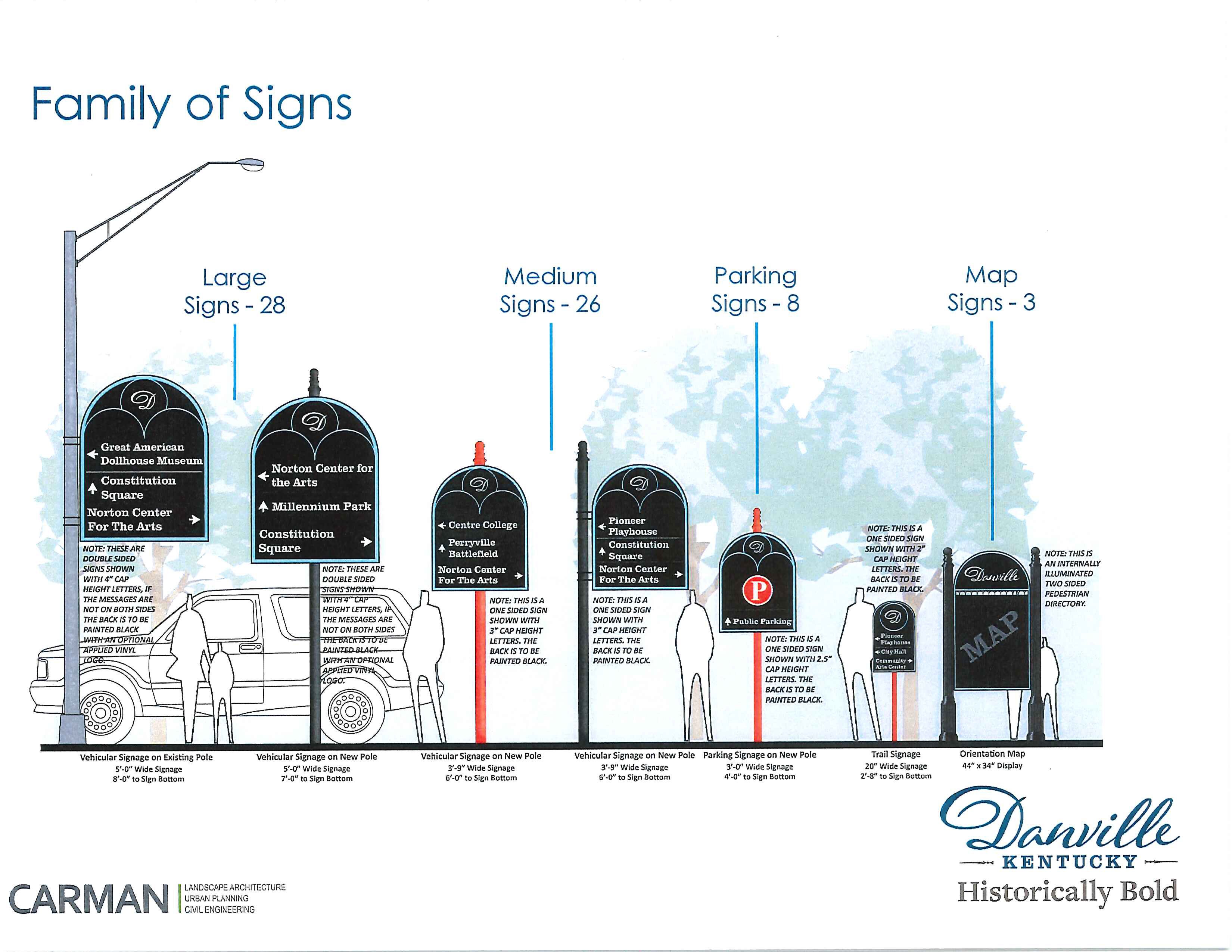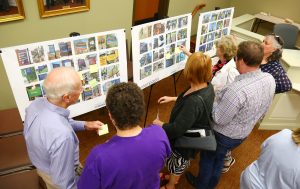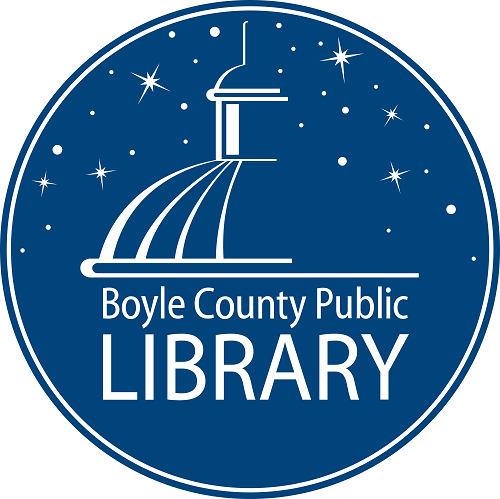Danville approves one extra sign for dollhouse museum in wayfinding plan
Published 7:37 pm Friday, December 13, 2019

- Carman A wayfinding master plan developed for Danville recommends a "traditional" uniform style for signs throughout the city, featuring a "D" for Danville along a curved top intended to mimic the architecture of some windows in the city. (File photo)
After a lengthy discussion Monday night, the Danville City Commission approved one additional sign on the wayfinding plan, at an estimated cost of $5,000, to designate for the Great American Dollhouse Museum. Now, City Engineer John Cassel will go forward with getting encroachment permits, which are needed from the state in order to begin the whole process.
The permits could take up to a year to be approved, something that threw commissioners for a loop when they learned about the timeline in a project “refresher” Cassel was asked to give Monday. And the city attorney strongly cautioned the commission about making the move to add the extra sign, citing fairness to other attractions and business owners.
The process
The wayfinding plan was presented to the commission in August of 2018, after public forums were held helping to complete a study by John Carman, a consultant who provided what city officials said should serve as a blueprint. Carman was paid to identify “decision points” around Danville where signs can lead car and foot traffic, as well as what locations should be included on those signs.
As the plan was announced upon completion, some in the public had problems with what signs were going where, and how many; Lori Kagan-Moore, owner of the Dollhouse Museum on Swope Drive, has been the most vocal about that. It calls for her museum to be identified on signs incoming from the north, and she is disappointed it isn’t included on signage designated for the south and west sides of the city.
Kagan-Moore has been talking to commissioners since the plan was made public, in an attempt to get five more signs included. This, as well as input from other community members, has made the commission cautious about going full steam ahead with the plan exactly as adopted.

Ben Kleppinger/ben.kleppinger@amnews.com
Community members use sticky notes to vote for one of three different styles of signage that could be recommended in the city’s wayfinding master plan during a forum last year. (File photo)
Consultant Carman had previously told the commission the quality of the signs is more important than the quantity or what was on them, due to drivers heavily relying on GPS. He said it’s more about making the area attractive with a more uniform message to visitors, and that it “actually started by an admonition from the state highway department to the community that, ‘let’s try and clean up the clutter of the signs.'”
When the plan was put up for a vote last year, then-City Engineer Earl Coffey (now municipal utility engineer) told the commission that once it was approved, staff would pursue pricing and begin the plan’s implementation, which worried some commissioners about approving it.
It was at first tabled after a motion by Commissioner J.H Atkins, who wanted more time to review it. Commissioner Denise Terry also had said she needed to absorb the plan, which she described as “overwhelming and very difficult to look at and visualize,” and that she would possibly drive around to look at intersections where proposed signs would be placed. But the plan was eventually approved, with the understanding that commissioners could make changes or “tweaks” and be involved in the process, which will be handled in phases according to sectors.
Periodically, Atkins and other commissioners had asked for updates about the master plan in subsequent meetings. In August of this year, City Manager Scott said city staff agreed with the commission “that we could have various phases … brought before the city commission for your approval as we implement that.” But he explained that due to projects the city staff had been engulfed in — like streetscape improvements and the Second Street bridge replacement — as well as the state’s lane reduction of Main Street, it would take some time to enter the permit process.
“It’s going to be a little while before the state will likely respond to our written request for encroachment permits,” he previously told the commission, and that the action would be “a little bit more in the future.”
Staff recommendations
Monday, City Engineer Cassel said staff met with Kagan-Moore and recommended that instead of adding several new signs, a smaller sign for northbound traffic should be added on U.S. 127 at Maple Avenue.
“It would add closer to only $5,000 to the overall cost,” Cassel said, adding that Kagan-Moore’s request of five additional signs would require an estimated additional $45,000. He said those are “conservative estimates,” and he wouldn’t know the exact costs until the project is bid out.
Cassel reminded the commission that the plan tries to get away from “specifics of individual businesses and that sort of thing,” and that signs on the outer loop of town, such as on the bypass, are about getting people into town, where there could be more specific attraction signs. He said the city would “love to be able to help more people,” but they can only add so many attractions before it becomes cluttered again or gets “way too expensive.”
Cassel said the state only allows two signs in each direction, with three locations listed on each sign.
Commissioner Terry said she thought the commission was going to “get the plan of how much money we’re going to spend on this in the first phase, and where those signs are going to go. So is there progress with that?”
Cassel said the first phase is applying for the encroachment permits. At first, staff thought an application would be needed for each sign, which would have totaled about 54. However, Cassel said Robert Baker with the department of transportation, District 7’s permit supervisor who he’s been working closely with, has been “a great help” and advised the city can do a blanket permit with a list of coordinates. Baker will then turn the applications over to state engineers. Cassel gave a best and worst case scenario of four months to a year for approval. The city would begin doing the outer loop of signs first, then start working on the downtown area.
Cassel said due to the commission’s concern about adding/changing signs, he’s still waiting to find out if additions can be made after the permit process is completed, or if making those changes would mean starting the whole permit process all over again since it strays from the adopted plan.
“But did I hear you say that those permits haven’t even been applied for? And we may be another year out?” Terry said. Cassel said yes.
“Well, I just have to say, that really is unacceptable. We have talked about this ad nauseum, and we are already three years in … My main question is why is this permitting process and this step still a year away?” Terry asked.
She wondered if there is a “disconnect” with the state or within city staff, “or is this just not a priority? … That is really unacceptable.”
Cassel, who came on with the city after the Wayfinding Master Plan was initiated, had no reply.
“John, she’s not directing that at you, you’ve not been here long enough to know the history, but for once I agree with her,” Commissioner Atkins said, partly joking. He then asked Cassel if he had a pencil and to write down some suggestions he had, which were about adding the Dollhouse Museum to certain signs, some of which would entail taking off another location, such as city hall, others which would add cost.
Cassel explained directional and other issues with Atkins’ placement suggestions; he said changing the plan is complicated, and “if you squeeze one thing, another thing gets changed …”
Atkins said there is $90,000 in the budget reserved for the wayfinding project, and even if additions would cost, it’s “something that should be looked into,” as well as finding out how strict the state would be about adding a fourth destination to some signs.
Commissioner Kevin Caudill said he also agreed with Terry’s assertion. “We’ve been at this a long time to be no more further along than we are.” He asked Cassel, “what sort of answers did you want from us tonight?”
Cassel said he was asked to provide the information to the commission again, in order to begin with phase I.
Kagan-Moore spoke up from the audience about some other ideas for signage for her business, including larger destination signs out on the bypass, which Coffey later estimated could cost around $10,000 each.
Kagan-Moore told the commission that traffic coming in from Perryville, Junction City or Stanford “would never have passed any kind of sign that said ‘Dollhouse Museum.’ … We’re kind of hidden away and tucked in there … but we are a significant attraction in this town. We’re one of the only things that’s open all day, every day, all year long.”
She said she knows the commission has received “letters from a lot of the restaurants saying we do promote them and send a lot of business their way … I would really like the support of the city to get some visibility there.”
Kagan-Moore reminded them that during past public forums, some community members stood up and spoke to second her notion about the museum.
Atkins said he trusts Cassel to “bring about some balance” in the plan and “keep on working on this in an equitable way.” He said even though Cassel said they are trying to stay away from specific businesses, he noticed a “very specific” business listed on the signage “six or seven times, and it’s on the outskirts of town,” and that there are only “about four or five major venues that are highlighted” within the plan.
“I don’t understand why it’s so complex to get some balance,” Atkins said. He mentioned “distilleries,” apparently referring to Wilderness Trail, which is a Kentucky Bourbon Trail destination.
Cassel said signs designating “downtown” are in the report “a lot, but that’s the idea — to get people downtown, in that direction.” However, he pointed out that Danville and Boyle high schools, for example, are both mentioned twice, and “the Dollhouse is in there eight times.”
He said the issue with adding the museum signs out on the south end of town is that “you’re putting a specific destination on the outer loop, where you’re trying to get the general direction signs in …”
Kagan-Moore brought up an expert she said contests the idea of “general direction signs.” She said according to this expert, whatever is unique to your town should be “put out there where people can see it.” She said due to there being only six dollhouse museums in the nation, it’s a prime example of placemaking and putting unique venues out front.
Clarity from Dexter
City Attorney Stephen Dexter jumped in after much discussion. “May I offer a suggestion to facilitate the conversation?”
Dexter clarified that the master plan is not a 3-year-old report, as Terry had initially insinuated; it was just returned last year, although he realized the commission had been talking about wayfinding for longer.
He said as shown by the in-depth conversation, the issue “is complicated and complex, for which you hired an independent, third-party contractor to navigate the process. During said process, there were multiple community forums for all interested parties to participate. I would caution you … to make amendments or take meetings outside of public forums … with all due respect to Ms. Kagan-Moore … I think it’s inappropriate for staff to meet individually with concerned business owners” or those who have an interest in the project, outside of a public forum. “For which I’m certain Ms. Kagan-Moore was present …”
He said in order to gear the commission “toward fairness and process,” and taking into consideration that a study was already done by a paid consultant, there could be counterpoints made by other business owners or attractions within the community “that did not have advance notice of your decision-making tonight, which I would caution you against.”
Dexter told the commission it has a plan before it, and it should make a motion to direct staff to apply for permits. “We know that’s now a four- to 12-month process,” he said, but nothing happens until the application is received and approved by the state.
“Until that’s received, you’re talking about decorating a cake for which you have no ingredients.”
After Atkins and Terry expressed more frustration with their confusion over what they thought they were going to be presented, Cassel said he simply needed the “OK” to get permits, and that he would continue researching the topic of making changes to the signs.
Cassel asked the commission to approve “and let me do my job, and Earl do his job … because right now, I’m spending time coming to you all with presentations about this when I could be doing other things” in order to start the process.
Caudill made the motion to add one additional sign for the Dollhouse Museum; Terry seconded it, and the commission unanimously approved the move.
Resident James Hunn interrupted the meeting to express his dissatisfaction with the city spending “my money, that’s taxpayers’ dollars,” to pay for an additional $5,000 sign.






